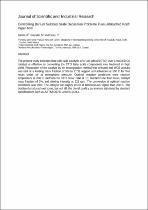 ResearchSpace
ResearchSpace
Controlling Barium Sulphate Scale Deposition Problems in an unbleached Kraft Paper Mill
JavaScript is disabled for your browser. Some features of this site may not work without it.
- ResearchSpace
- →
- Research Publications/Outputs
- →
- Journal Articles
- →
- View Item
| dc.contributor.author |
Sithole, Bishop B

|
|
| dc.contributor.author |
Doucette, M

|
|
| dc.contributor.author |
Fiolet, R

|
|
| dc.date.accessioned | 2016-02-23T09:32:36Z | |
| dc.date.available | 2016-02-23T09:32:36Z | |
| dc.date.issued | 2015-06 | |
| dc.identifier.citation | Sithole, BB, Doucette, M and Fiolet, R.2015. Controlling Barium Sulphate Scale Deposition Problems in an unbleached Kraft Paper Mill. Journal of Scientific and Industrial Research, Vol. 74(04), pp. 236-244 | en_US |
| dc.identifier.issn | 0022-4456 | |
| dc.identifier.uri | http://hdl.handle.net/10204/8429 | |
| dc.description | Copyright: 2015 NISCAIR. Due to copyright restrictions, the attached PDF file only contains the post-print version of the full text item. For access to the full text item, please consult the publisher's website. The definitive version of the work is published in Journal of Scientific and Industrial Research, Vol. 74(04), pp. 236-244 | en_US |
| dc.description.abstract | Troubleshooting of scale deposits and defects in paper samples showed that the problem was caused by barium sulphate and calcium sulphate scales. However, it was ascertained that barium sulphate was more of a concern than calcium sulphate as it is more tenacious than the calcium sulphate scale. A study of the inputs of the scale components found that the major inputs of barium into the mill system were the wood chips and bark contamination. The major inputs of the sulphate component of the scale were sulphuric acid used for pH control and alum used for rosin sizing.Evaluation of several options for mitigating the scale deposition problem showed that bark removal and continuous application of a scale inhibitor comprised of phosphates/phosphonates and polyacrylates were effective in reducing and controlling the scale deposit problems. Institution of these measures led to a cleaner paper machine that required far fewer boil outs than before. In addition, productivity improved and the fisheye defects disappeared.A rapid method was developed for on-site estimation of barium levels in mill process samples. The data were used to adjust the dosage of the scale inhibitor to ensure optimum effectiveness of the programme. | en_US |
| dc.language.iso | en | en_US |
| dc.publisher | NISCAIR | en_US |
| dc.relation.ispartofseries | Workflow;15603 | |
| dc.subject | Scale | en_US |
| dc.subject | PH control | en_US |
| dc.title | Controlling Barium Sulphate Scale Deposition Problems in an unbleached Kraft Paper Mill | en_US |
| dc.type | Article | en_US |
| dc.identifier.apacitation | Sithole, B. B., Doucette, M., & Fiolet, R. (2015). Controlling Barium Sulphate Scale Deposition Problems in an unbleached Kraft Paper Mill. http://hdl.handle.net/10204/8429 | en_ZA |
| dc.identifier.chicagocitation | Sithole, Bishop B, M Doucette, and R Fiolet "Controlling Barium Sulphate Scale Deposition Problems in an unbleached Kraft Paper Mill." (2015) http://hdl.handle.net/10204/8429 | en_ZA |
| dc.identifier.vancouvercitation | Sithole BB, Doucette M, Fiolet R. Controlling Barium Sulphate Scale Deposition Problems in an unbleached Kraft Paper Mill. 2015; http://hdl.handle.net/10204/8429. | en_ZA |
| dc.identifier.ris | TY - Article AU - Sithole, Bishop B AU - Doucette, M AU - Fiolet, R AB - Troubleshooting of scale deposits and defects in paper samples showed that the problem was caused by barium sulphate and calcium sulphate scales. However, it was ascertained that barium sulphate was more of a concern than calcium sulphate as it is more tenacious than the calcium sulphate scale. A study of the inputs of the scale components found that the major inputs of barium into the mill system were the wood chips and bark contamination. The major inputs of the sulphate component of the scale were sulphuric acid used for pH control and alum used for rosin sizing.Evaluation of several options for mitigating the scale deposition problem showed that bark removal and continuous application of a scale inhibitor comprised of phosphates/phosphonates and polyacrylates were effective in reducing and controlling the scale deposit problems. Institution of these measures led to a cleaner paper machine that required far fewer boil outs than before. In addition, productivity improved and the fisheye defects disappeared.A rapid method was developed for on-site estimation of barium levels in mill process samples. The data were used to adjust the dosage of the scale inhibitor to ensure optimum effectiveness of the programme. DA - 2015-06 DB - ResearchSpace DP - CSIR KW - Scale KW - PH control LK - https://researchspace.csir.co.za PY - 2015 SM - 0022-4456 T1 - Controlling Barium Sulphate Scale Deposition Problems in an unbleached Kraft Paper Mill TI - Controlling Barium Sulphate Scale Deposition Problems in an unbleached Kraft Paper Mill UR - http://hdl.handle.net/10204/8429 ER - | en_ZA |





